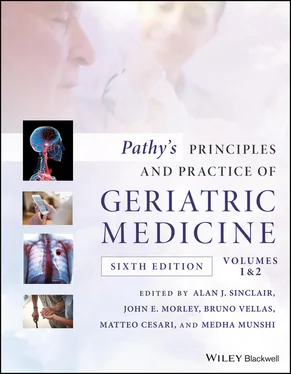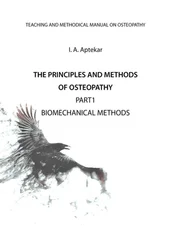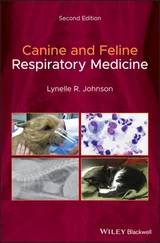Pathy's Principles and Practice of Geriatric Medicine
Здесь есть возможность читать онлайн «Pathy's Principles and Practice of Geriatric Medicine» — ознакомительный отрывок электронной книги совершенно бесплатно, а после прочтения отрывка купить полную версию. В некоторых случаях можно слушать аудио, скачать через торрент в формате fb2 и присутствует краткое содержание. Жанр: unrecognised, на английском языке. Описание произведения, (предисловие) а так же отзывы посетителей доступны на портале библиотеки ЛибКат.
- Название:Pathy's Principles and Practice of Geriatric Medicine
- Автор:
- Жанр:
- Год:неизвестен
- ISBN:нет данных
- Рейтинг книги:3 / 5. Голосов: 1
-
Избранное:Добавить в избранное
- Отзывы:
-
Ваша оценка:
- 60
- 1
- 2
- 3
- 4
- 5
Pathy's Principles and Practice of Geriatric Medicine: краткое содержание, описание и аннотация
Предлагаем к чтению аннотацию, описание, краткое содержание или предисловие (зависит от того, что написал сам автор книги «Pathy's Principles and Practice of Geriatric Medicine»). Если вы не нашли необходимую информацию о книге — напишите в комментариях, мы постараемся отыскать её.
Pathy’s Principles and Practice of Geriatric Medicine
Pathy's Principles and Practice of Geriatric Medicine — читать онлайн ознакомительный отрывок
Ниже представлен текст книги, разбитый по страницам. Система сохранения места последней прочитанной страницы, позволяет с удобством читать онлайн бесплатно книгу «Pathy's Principles and Practice of Geriatric Medicine», без необходимости каждый раз заново искать на чём Вы остановились. Поставьте закладку, и сможете в любой момент перейти на страницу, на которой закончили чтение.
Интервал:
Закладка:
41 41. Singer DE, Chang Y, Fang MC, et al. The net clinical benefit of warfarin anticoagulation in atrial fibrillation. Ann Intern Med. 2009; 151:297–305.
42 42. Aujesky D, Smith KJ, Roberts MS. Oral anticoagulation strategies after a first idiopathic venous thromboembolic event. Am J Med. 2005; 118:625–635.
43 43. Mant J, Hobbs FDR, Fletcher K, et al. Warfarin versus aspirin for stroke prevention in an elderly community population with atrial fibrillation (the Birmingham Atrial Fibrillation Treatment of the Aged Study, BAFTA): a randomised controlled trial. Lancet. 2007; 370:493–503.
44 44. Sharma M, Cornelius VR, Patel JP, et al. Efficacy and harms of direct oral anticoagulants in the elderly for stroke prevention in atrial fibrillation and secondary prevention of venous thromboembolism: systematic review and meta‐analysis. Circulation. 2015; 132:194–204.
45 45. Kato ET, Goto S, Giugliano RP. Overview of oral antithrombotic treatment in elderly patients with atrial fibrillation. Ageing Research Reviews. 2019; 49:115–124.
46 46. Caldeira D, Nunes‐Ferreira A, Rodrigues R, et al. Non‐vitamin K antagonist oral anticoagulants in elderly patients with atrial fibrillation: A systematic review with meta‐analysis and trial sequential analysis. Archives of Gerontology and Geriatrics. 2019; 81:209–214.
47 47. Malik AH, Yandrapalli S, Aronow WS, et al. Meta‐analysis of direct‐acting oral anticoagulants compared with warfarin in patients >75 years of age. Am J Cardiol. 2019; 123:2051−2057.
48 48. Hagerty T, Rich MW. Fall risk and anticoagulation for atrial fibrillation in the elderly: A delicate balance. Cleve Clin J Med. 2017; 84:35–40.
49 49. Horstkotte D, Schulte H, Bircks W, Strauer B. Unexpected findings concerning thromboembolic complications and anticoagulation after complete 10 year follow up of patients with St. Jude Medical prostheses. J Heart Valve Dis. 1993; 2:291–301.
50 50. Farmakis D, Davlouros P, Giamouzis G, et al. Direct oral anticoagulants in nonvalvular atrial fibrillation: practical considerations on the choice of agent and dosing. Cardiology. 2018; 140:126–132.
51 51. Sellers MB, Newby LK. Atrial fibrillation, anticoagulation, fall risk, and outcomes in elderly patients. Am Heart J. 2011; 161:241–246.
52 52. Man‐Son‐Hing M, Nichol G, Lau A, Laupacis A. Choosing antithrombotic therapy for elderly patients with atrial fibrillation who are at risk for falls. Arch Intern Med. 1999; 159:677–685.
53 53. Douros A, Renoux C, Yin H, et al. Concomitant use of direct oral anticoagulants with antiplatelet agents and the risk of major bleeding in patients with nonvalvular atrial fibrillation. Am J Med. 2019; 132:191–199.
54 54. Palareti G, Poli D. The prevention of venous thromboembolism recurrence in the elderly: a still open issue. Expert Review of Hematology. 2018; 11:903–909.
55 55. Palareti G, Hirsh J, Legnani C, et al. Oral anticoagulation treatment in the elderly: a nested, prospective, case‐control study. Arch Intern Med. 2000; 160:470–478.
56 56. Hylek EM, Evans‐Molina, Shea C, et al. Major hemorrhage and tolerability of warfarin in the first year of therapy among elderly patients with atrial fibrillation. Circulation. 2007; 115:2689–2696.
57 57. Research Committee of the British Thoracic Society. Optimum duration of anticoagulation for deep‐vein thrombosis and pulmonary embolism. Lancet. 1992; 340:873–876.
58 58. Siguret V, Gouin I, Debray M, et al. Initiation of warfarin therapy in elderly medical inpatients: a safe and accurate regimen. Am J Med. 2005; 118:137–142.
59 59. Wang Y, Kong MC, Lee LH, et al. Knowledge, satisfaction, and concerns regarding warfarin therapy and their association with warfarin adherence and anticoagulation control. Thromb Res. 2014; 133:550–554.
60 60. Suarez C, Castilla‐Guerra L, Cantero J, et al. Satisfaction with oral anticoagulants in patients with atrial fibrillation. Patient Preference and Adherence. 2018: 12 267–274.
61 61. Murthy SB, Gupta A, Merkler AE, et al. Restarting anticoagulant therapy after intracranial hemorrhage: a systematic review and meta‐analysis. Stroke. 2017; 48:1594–1600.
62 62. Perreault S, Côté R, White‐Guay B, et al. Anticoagulants in older patients with nonvalvular atrial fibrillation after intracranial hemorrhage. J Stroke. 2019; 21:195–206.
63 63. Vivas D, Roldan I, Ferrandis R, et al. Perioperative and periprocedural management of antithrombotic therapy: consensus document of SEC, SEDAR, SEACV, SECTCV, AEC, SECPRE, SEPD, SEGO, SEHH, SETH, SEMERGEN, SEMFYC, SEMG, SEMICYUC, SEMI, SEMES, SEPAR, SENEC, SEO, SEPA, SERVEI, SECOT and AEU. Rev Esp Cardiol. 2018; 71:553–564.
64 64. Rivera‐Caravaca JM, Roldán V, Esteve‐Pastor MA, et al. Importance of time in therapeutic range on bleeding risk prediction using clinical risk scores in patients with atrial fibrillation. Sci Rep. 2017; 7:12066.
65 65. Dar T, Turagam MK, Yarlagadda B, et al. Indication, patient selection, and referral pathways for left atrial appendage closure. Interv Cardiol Clin. 2018; 7:169–183.
66 66. Petidier R, Abizanda P, Noguerón A, et al. Anticoagulación en población anciana con fibrilación auricular no valvular. Artículo de revisión. Rev Esp Geriatr Gerontol. 2018; 53:344–55.
CHAPTER 26 Myelodysplasia
Domenico Fusco, Andrea Bellieni, Beatrice Di Capua, and Giuseppe Colloca
Fondazione Policlinico Agostino Gemelli IRCCS, Università Cattolica del Sacro Cuore, Rome, Italy
Introduction
The myelodysplastic syndromes (MDSs) are a heterogeneous group of malignant hematopoietic stem cell disorders characterized by cytopenia due to dysplastic and ineffective blood cell production and potential variable risk of transformation to acute leukaemia. 1,2These disorders are sporadic and arise de novo or may result after exposure to certain forms of environmental toxins (e.g. benzene), radiation (e.g. therapeutic or accidental), and chemotherapy exposure as alkylating agents (secondary MDS). 3,4MDS primarily affects older patients, with an onset mean age over 70 and an increased incidence with advancing age. 5,6The secondary MDSs are not age‐related, although they are extremely rare in children, where monocytic leukaemia can be observed. The incidence has increased over time because of the increased recognition of this disease by medical doctors, as well as the ageing of the population. The demographics in developed countries shift toward older patient populations due to increased longevity and better quality of healthcare, so more people are receiving intensive treatments like chemotherapy.
MDS may easily be overlooked in elderly patients. It can present simply as a chronic macrocytic anaemia, and there may be a tendency to ‘leave well enough alone’ in an older patient with multiple comorbidities.
However, our understanding of MDS continues to improve, so we can use geriatric knowledge in assessing complex older and oldest‐old patients, to recognize and measure frailty and identify fit and the unfit patients. Better treatment strategies have been developed to prolong life and delay transformation to acute leukaemia, reducing the risk of major complications such as anaemia, bleeding, and severe infections. The majority of patients cannot tolerate intensive therapeutic approaches such as allogeneic hematopoietic stem cell transplantation. For this reason, treatment needs to be risk‐adapted and tailored to the frail old patient, involving the definition of different goals of therapy according to the risk status of the patient. 7
Epidemiology and clinical presentation
Myelodysplastic syndromes are the most common hematologic neoplasms in the elderly, and the incidence of MDS in the US is expected to double from 2000 to 2030 as the result of population ageing. 8,9
Читать дальшеИнтервал:
Закладка:
Похожие книги на «Pathy's Principles and Practice of Geriatric Medicine»
Представляем Вашему вниманию похожие книги на «Pathy's Principles and Practice of Geriatric Medicine» списком для выбора. Мы отобрали схожую по названию и смыслу литературу в надежде предоставить читателям больше вариантов отыскать новые, интересные, ещё непрочитанные произведения.
Обсуждение, отзывы о книге «Pathy's Principles and Practice of Geriatric Medicine» и просто собственные мнения читателей. Оставьте ваши комментарии, напишите, что Вы думаете о произведении, его смысле или главных героях. Укажите что конкретно понравилось, а что нет, и почему Вы так считаете.












